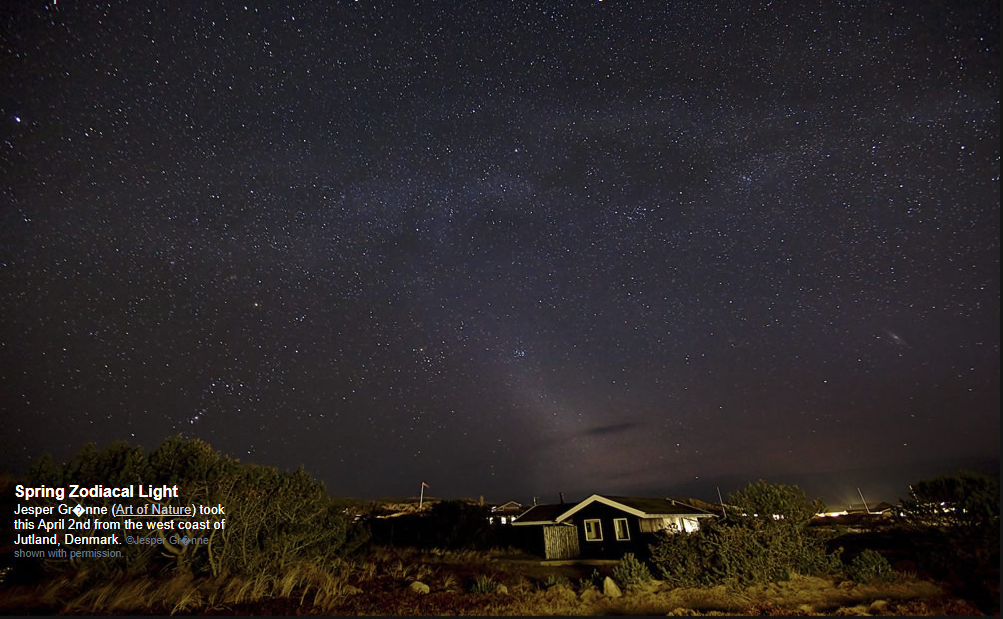Spring Zodiacal Light
Spring Zodiacal Light: A Spectacular Celestial Phenomenon
Zodiacal Light, a captivating atmospheric optical phenomenon, occurs when sunlight scatters off a vast disk of interplanetary dust that extends all the way to the orbit of Jupiter. This disk consists of minuscule dust particles measuring between 0.001 and 0.3 mm in diameter, with each particle separated by miles from its neighbors. Aligned with the plane of the Solar System, the dust disk becomes visible along the path of the sun against the backdrop of stars, known as the ecliptic.
This enchanting spectacle manifests as a cone of ethereal, pearly light that stretches upwards from the horizon after sunset and before dawn. To witness this celestial phenomenon in all its glory, it is crucial to be in an area with minimal light pollution and when the sky is suitably dark, devoid of moonlight. If the Zodiacal Light is not immediately apparent, give your eyes some time to adjust to the darkness, and try observing it first using your peripheral vision, which is more sensitive to faint light.
In the northern hemisphere, the best time to observe the Spring Zodiacal Light in the evening is typically from February to early March when the ecliptic is tilted at a steep angle. During this period, the sun's position below the horizon allows for optimal visibility of this captivating phenomenon.
Renowned astrophotographer Jesper Grønne managed to capture a stunning image of the Spring Zodiacal Light with the sun positioned 19° below the horizon. This shot presents one of the last opportunities to witness this awe-inspiring display during spring. As we progress further into the season, the Zodiacal Light will eventually blend into the luminosity of the Milky Way star clouds in Taurus and Gemini, making it increasingly challenging to distinguish.
However, fear not! The next excellent opportunity to experience the Zodiacal Light will arise in the pre-dawn skies starting from September onwards, particularly for those residing in the northern hemisphere. During this time, the ecliptic will once again offer an ideal vantage point to witness this celestial phenomenon before the break of day.
To optimize your chances of observing the Zodiacal Light, here are some helpful tips:
- Seek out a location away from artificial lights to minimize light pollution.
- Wait for the sky to become sufficiently dark, allowing at least 15 minutes for your eyes to adjust to the darkness.
- Utilize your peripheral vision to increase your sensitivity to faint light.
- Familiarize yourself with the path of the ecliptic to identify the direction in which the Zodiacal Light will appear.
- Consider using binoculars or a camera with long-exposure capabilities to enhance your viewing experience and capture stunning photographs of this ethereal phenomenon.
Remember, patience and perseverance are key when attempting to witness the Spring Zodiacal Light. Mother Nature's celestial wonders often require a combination of favorable conditions and a keen eye to behold. So, mark your calendars and prepare for an extraordinary encounter with one of nature's most remarkable displays—the Spring Zodiacal Light.

Spring Zodiacal Light
Jesper Gr�nne (Art of Nature) took this April 2nd from the west coast of Jutland, Denmark. ©Jesper Gr�nne, shown with permission.

The Zodiacal Light is sunlight scattered from a vast disk of interplanetary dust stretching out to the orbit of Jupiter. The dust particles are only 0.001 - 0.3 mm across and on average each is separated by miles from its neighbours. The dust disk lies in the plane of the Solar System and so appears along the path of the sun against the stars - the ecliptic.
It is visible as a cone of pearly light stretching upwards from the horizon after sunset and before dawn. The sky must be properly dark with no moon to interfere. There should also be minimal pollution from artificial lights. If it is not apparent after being in the dark for 15 minutes or so, move your head and eyes to catch it first in your more sensitive peripheral vision.
The best time to see it in the evening in the northern hemisphere is February to early March. The ecliptic is then strongly tilted upwards.
Jesper has captured it with the sun 19° below the horizon and in perhaps the last Spring opportunity. Soon the Zodiacal Light will overlap the Milky Way star clouds of Taurus and Gemini and be lost against their light.
September onwards will be the next good opportunity - in pre-dawn skies - for those of us in the north.
More observing tips here.
Note: this article has been automatically converted from the old site and may not appear as intended. You can find the original article here.
Reference Atmospheric Optics
If you use any of the definitions, information, or data presented on Atmospheric Optics, please copy the link or reference below to properly credit us as the reference source. Thank you!
-
<a href="https://atoptics.co.uk/blog/spring-zodiacal-light/">Spring Zodiacal Light</a>
-
"Spring Zodiacal Light". Atmospheric Optics. Accessed on November 26, 2024. https://atoptics.co.uk/blog/spring-zodiacal-light/.
-
"Spring Zodiacal Light". Atmospheric Optics, https://atoptics.co.uk/blog/spring-zodiacal-light/. Accessed 26 November, 2024
-
Spring Zodiacal Light. Atmospheric Optics. Retrieved from https://atoptics.co.uk/blog/spring-zodiacal-light/.